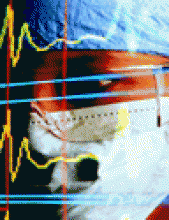Tissue engineering has yet to yield a good source of bone for orthopedic surgery. So far, attempts to grow bone tissue in vitro have not been successful.1 However, new research by Molly Stevens and colleagues suggests that new bone can be engineered to grow in vivo and then used to repair damage elsewhere.1

Figure. Normal vertebral bone. Photo by: WebPath/Edward C. Klatt, MD
Autologous bone is used in the treatment of severe fractures and bone tumour resections and for spinal fusions, of which more than 200 000 are performed annually in the United States alone.1 Currently, living bone is often harvested from the iliac crest. However, this supply is limited, and harvesting results in pain and morbidity among patients. Tissue engineering is also a challenge since bone is a highly organized and complex tissue. Previous attempts at in vivo culture have involved using a mineralized bone scaffold placed in muscle tissue;2 the results of this procedure, however, have been unreliable.
Stevens and colleagues have demonstrated that new bone may be generated in the space between bone and its overlying periosteum. This site was chosen to act as an in vivo “bioreactor” because the periosteum contains pluripotent cells that are mobilized for healing the bone after an injury. The researchers injected a gel of calcium alginate into the space next to the tibia of New Zealand white rabbits, and they observed a proliferation of cells in the periosteum.
However, this proliferation did not appear to be a typical wound-healing response. Instead, after 2 weeks, bone formation was underway. The difference between wound-healing and bone formation was linked to the size of the pinhole incision used to make the “bioreactor,” since a longer incision resulted in the formation of scar tissue instead of bone. By day 10, woven bone was seen as the calcium alginate gel disappeared. After 6 weeks, the engineered bone had all of the histologic markers of native bone, and in another 6 weeks it had become mature, compact bone.
It was unclear whether the new bone could be harvested and integrated into a recipient site. However, Stevens and colleagues found that the new bone had a demarcation that allowed it to be removed without compromising the surrounding bone. It was then grafted onto another site on the tibia, where it remodelled and integrated into the existing bone.
Whether an “in vivo bioreactor” will work in humans for the banking and transplantation of bone is still an open question. But Stevens and colleagues have already discovered that a 1-cm space can be created between human tibiae and the mesenchymal cambium layer.1 This finding, combined with the ease of their method, which simply takes advantage of the natural healing process of the body, suggests that “bioreactors” may be an important new way to engineer a variety of tissues (Stevens and colleagues have also been able to create cartilage with the technique).1 As such, orthopedic surgeons may one day have an unlimited supply of bone grown right in the patients who need it.











